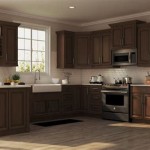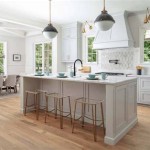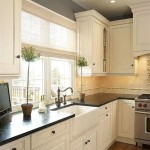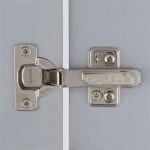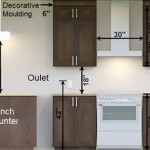What Color Paint Goes With Dark Grey Cabinets?
Dark grey cabinets have steadily climbed in popularity, finding their place in modern kitchens, bathrooms, and even home offices. Their versatility stems from their ability to act as a sophisticated neutral backdrop, allowing for a range of complementary paint colors to be used on the surrounding walls. The key to selecting the ideal wall color lies in understanding the undertones of the specific grey used in the cabinets, the desired mood of the space, and the existing light conditions.
Dark grey, unlike true neutral grey, often leans towards either warm or cool undertones. Warm greys might reveal hints of brown, beige, or even a muted green, while cool greys tend to exhibit blue, violet, or slate undertones. Identifying these undertones is crucial as it directly impacts which colors will harmonize effectively. Pairing a warm-toned grey with a cool-toned paint, or vice versa, can result in a clash that detracts from the overall aesthetic.
Beyond undertones, the desired ambiance of the room is another significant consideration. A light and airy space can be achieved with brighter colors, while a more dramatic and intimate setting can be created with darker hues. The choice should also reflect the room's function; a kitchen might benefit from an energizing and stimulating color, while a bathroom might be better suited to calming and relaxing shades.
Finally, the amount of natural light available in the room heavily influences color perception. Darker colors can make a small, poorly lit room feel even smaller and more confined. Conversely, a bright room with ample natural light can handle deeper, more saturated colors without feeling oppressive.
Understanding Grey Undertones for Optimal Color Pairing
Accurately discerning the undertones in dark grey cabinets is the foundation for successful color selection. If the grey appears to have a subtle brownish or beige tint, it indicates a warm undertone. Swatches of paint colors containing similar warm hues, such as creams, warm whites, greiges (grey-beige), or even muted earthy tones, will likely complement the cabinets well. Conversely, if the grey has a distinct bluish or violet cast, it suggests a cool undertone. In this case, paints with cool undertones, for example, cool whites, pale blues, soft greens, or lavender, would create a harmonious look.
A simple test to identify undertones involves comparing the cabinet color to a true neutral grey swatch. Hold the samples side-by-side under good lighting (preferably natural daylight) and observe any subtle shifts in color. Does the cabinet grey appear warmer or cooler in comparison? Additionally, placing the cabinet sample next to paint chips that are known to have distinct warm and cool undertones can help to reveal the cabinet’s inherent tendency.
Once the undertone is identified, use it as a guide when exploring paint options. Instead of randomly selecting colors, focus on swatches that share the same underlying warmth or coolness. This streamlined approach significantly increases the likelihood of finding a visually appealing and cohesive pairing.
Careful consideration must be given to the intensity of the chosen color. While a warm white might be a safe and generally pleasing choice for a warm grey cabinet, the specific shade of warm white can make a substantial difference. A bright, stark white might appear too contrasting and sterile, while a softer, creamier white would likely harmonize better. Similarly, with cool greys, a light, icy blue can create a serene and sophisticated atmosphere, but a strong, overly saturated blue could overwhelm the space.
Leveraging Light and Shadow: Choosing Colors for Different Lighting Conditions
The amount of natural and artificial light in a room plays a crucial role in how color is perceived. A color that looks beautiful in a brightly lit showroom might appear completely different in a dimly lit kitchen. Therefore, it is essential to consider the lighting conditions of the space when selecting a paint color to complement dark grey cabinets.
In rooms with limited natural light, it is generally advisable to opt for lighter and brighter paint colors. These colors reflect more light, helping to make the room feel more open and airy. Colors like off-white, light greige, pastel shades, or even a soft, muted yellow, can help to counteract the darkness of the cabinets and prevent the room from feeling claustrophobic.
Using light-reflecting paint finishes, such as eggshell or satin, can further enhance the effect of these lighter colors. Avoid matte finishes, which tend to absorb light and can make a dark room feel even darker.
In contrast, rooms with abundant natural light can handle darker and more saturated colors without feeling overwhelming. Deep blues, greens, or even charcoal grey can create a dramatic and sophisticated look when paired with dark grey cabinets. However, it is important to maintain balance. Too much darkness can still make a room feel smaller than it is. Consider using lighter-colored accents, such as white trim or light-colored accessories, to break up the darkness and add visual interest.
Artificial lighting also needs to be taken into consideration. The color temperature of the bulbs used in the room can significantly affect the appearance of the paint color. Warm-toned bulbs (yellowish light) can make colors appear warmer, while cool-toned bulbs (bluish light) can make colors appear cooler. Experiment with different bulb types to see how they affect the paint samples before making a final decision.
Ultimately, it is advisable to test paint samples in the actual room, under both natural and artificial lighting conditions, before committing to a specific color. Paint a large swatch of the color on the wall and observe it at different times of the day to see how it changes with the light.
Creating Different Moods: Color Palettes for Dark Grey Cabinets
The choice of paint color can significantly influence the overall mood and atmosphere of a room. When selecting a color to complement dark grey cabinets, consider the desired feeling you want to create. Are you aiming for a calming and serene space, or a more energetic and stimulating environment?
For a calming and serene atmosphere, consider using soft, muted colors. Pale blues, soft greens, lavender, or even a very light grey can create a sense of tranquility and relaxation. These colors are particularly well-suited for bathrooms or bedrooms, where a peaceful ambiance is desired. Pairing these colors with natural materials, such as wood or stone, can further enhance the calming effect.
To create a more energetic and stimulating environment, opt for brighter and bolder colors. Yellows, oranges, reds, or even a vibrant turquoise can add a sense of excitement and vitality to a room. These colors are often used in kitchens or dining rooms, where a more social and lively atmosphere is desired. However, it is important to use these colors sparingly, as too much can be overwhelming. Consider using them as accent colors, rather than painting the entire room in a bold hue.
For a sophisticated and elegant look, consider using neutral colors in varying shades. Pairing dark grey cabinets with white or off-white walls is a classic and timeless choice. This combination creates a clean and minimalist look that is both stylish and versatile. Add interest to the space by incorporating textures, such as wood paneling or textured wallpaper. Using metallic accents, such as silver or gold, can further enhance the sense of sophistication.
To achieve a warm and inviting atmosphere, consider using earthy tones. Beige, brown, terracotta, or even a muted olive green can create a sense of comfort and coziness. These colors are particularly well-suited for living rooms or family rooms, where a relaxed and welcoming atmosphere is desired. Incorporating natural elements, such as plants or wood furniture, can further enhance the warmth of the space.
Ultimately, the best color palette for dark grey cabinets depends on your personal preferences and the desired mood of the room. Experiment with different colors and combinations until you find a look that you love.
Beyond the main wall color, consider the impact of trim color. White trim offers a crisp, clean contrast against dark grey cabinets and colored walls, while a grey trim that is a shade or two lighter than the cabinets can create a more subtle and blended look. The color of the trim can also be used to tie in other elements of the room, such as the flooring or the backsplash.
The selection of hardware and fixtures also influences the overall aesthetic. Silver or chrome hardware complements cool grey cabinets, while brass or bronze hardware pairs well with warm grey cabinets. The same principle applies to lighting fixtures and other decorative elements. By carefully coordinating these details, a cohesive and harmonious design can be achieved.
In conclusion, selecting the perfect paint color to complement dark grey cabinets involves careful consideration of undertones, lighting conditions, and the desired mood. By understanding these factors and experimenting with different options, a visually appealing and functional space can be created.

Favorite Kitchen Cabinet Paint Colors

Great Gray Kitchen Ideas When Redesigning Your Home Aco

Favorite Kitchen Cabinet Paint Colors

Grey Kitchen Cabinets Inspiration

Kitchen With Gray Cabinets Why To Choose This Trend Decoholic

12 Wall Colors That Go With Gray Kitchen Cabinets

Kitchen With Gray Cabinets Why To Choose This Trend Decoholic

Choosing Bathroom Paint Colors For Walls And Cabinets

Grey Kitchens Design Ideas Farrow Ball

The 6 Best Gray Paint Colors For Cabinets
Related Posts


